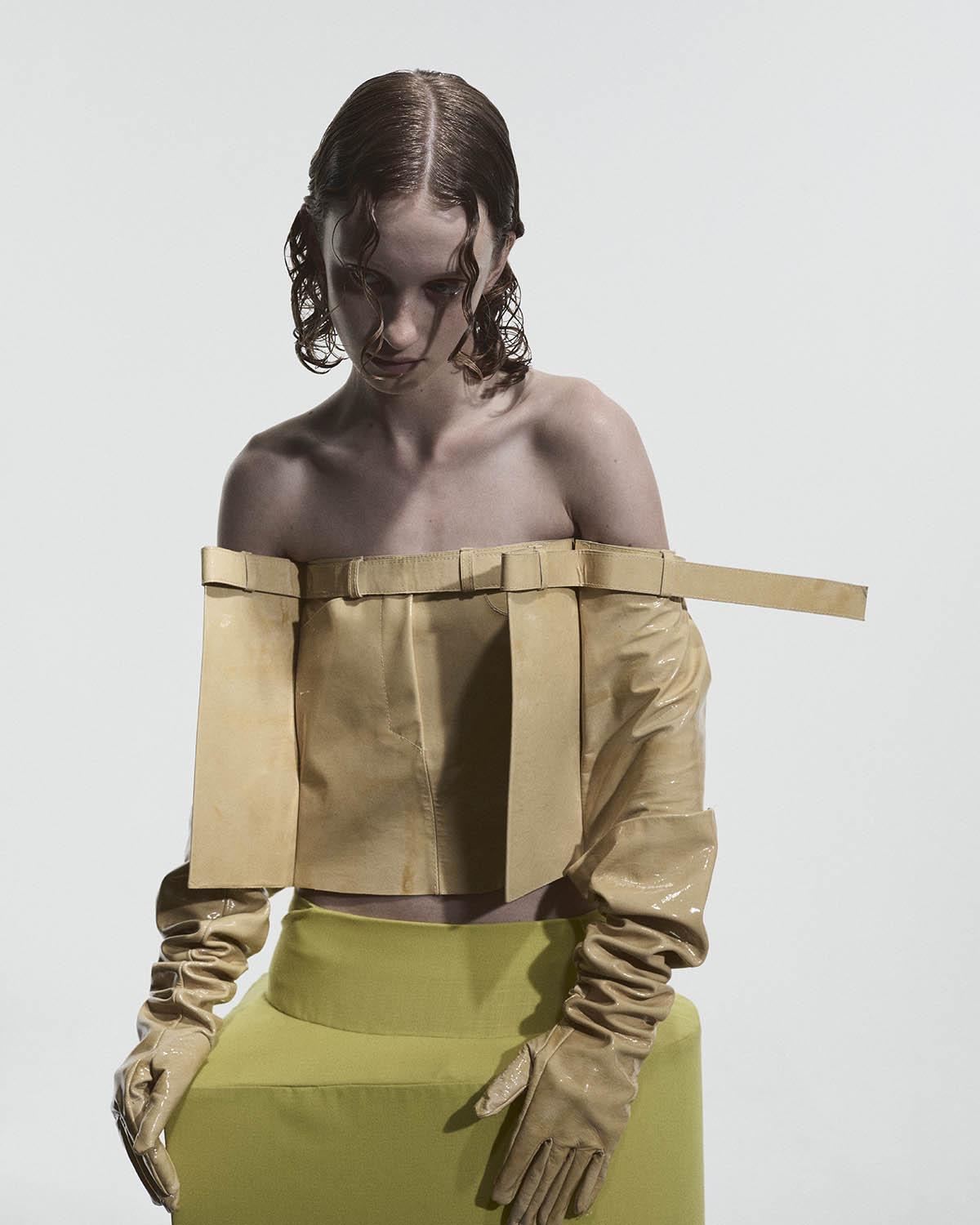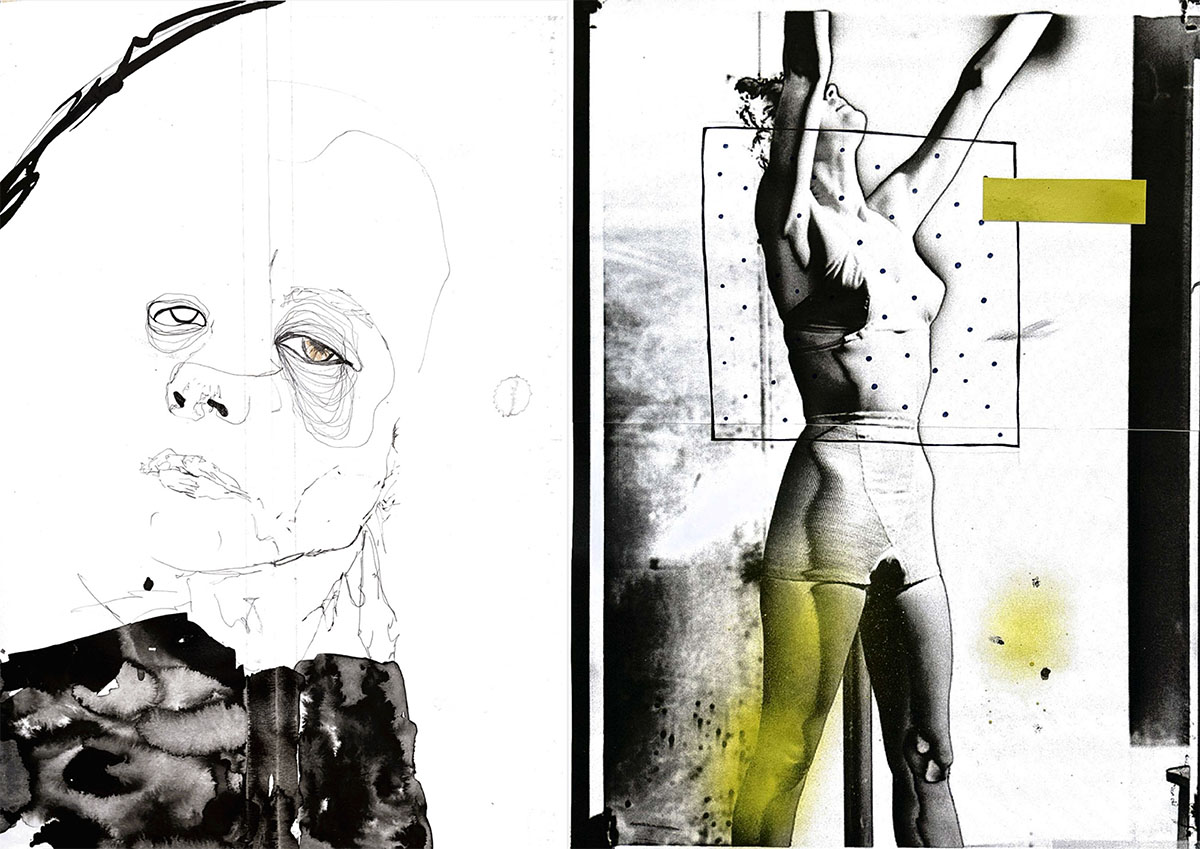
Who were your fashion idols growing up, and do they still inspire you today?
As a child, I wasn’t particularly focused on specific names or fashion icons. Instead, I was drawn to the visual elements of fashion that appealed to me. I often cut out images from fashion magazines featuring admired looks and hang them on my walls. For me, it was more about capturing styles and aesthetics than following the designers or public figures behind them. It wasn’t until I was in my twenties that I began to seriously consider a career in fashion and started paying more attention to influential figures in the industry. Before that, fashion was a way for me to express my taste and creativity without necessarily focusing on the names behind the designs.”


Chloë, you are finishing your master’s degree in the Fashion Department at the Royal Art Academy in Antwerp, Belgium. How was it for you to study there?
Studying at the Royal Academy of Fine Arts in Antwerp is incredibly intense. The strict deadlines and high expectations push you to work at a fast pace, constantly challenging your creativity. Although the pressure can be difficult at times, it is also an essential part of the learning process. „Struggling is learning“ is something I kept in mind throughout my time at the Academy. It’s in those moments of difficulty that I found the most growth, both creatively and personally. One of the key aspects of the Academy’s approach is the strong emphasis on developing your design language. They encourage you to dig deep into your vision and express it in a unique way, which is something I found both liberating and essential for my growth as a designer.


At the same time, the technical side of fashion, particularly tailoring, plays a crucial role. The Academy insists on a deep understanding of structure and construction, and this balance between creativity and craftsmanship is what truly shapes you as a designer. The process is demanding, but the rigor helps refine your ideas and forces you to stay true to your design identity. The Academy is not just about learning to make clothes; it’s about learning to communicate a vision through fashion and understanding the technical foundation needed to bring that vision to life. I appreciate the environment and the energy of being surrounded by my fellow students, all of whom bring their unique perspectives and creativity to the table. The collaborative atmosphere is something I find motivating, as it pushes me to think differently and broaden my creative horizons. I also value the close interactions with the professors, whose feedback and guidance are crucial in shaping my development as a designer. The open dialogue with both peers and faculty creates an inspiring space for growth, where ideas are constantly exchanged and refined.

Tell us about your “Press Ctrl+U” collection. It is about showing and hiding, but in a very thoughtful and calculated way, how it was to work on this collection—since the garments depended on millimeter measure and the fitting was a very important part.
Press Ctrl+U is a collection that originated from the creation of free graphic collages. These collages allowed shapes, colors, and materials to evolve organically and uninhibitedly. Through this creative process, my fascination with the relationship between flat surfaces and volume grew. This led to an innovative approach to coupe, where I could incorporate cuts in a new and challenging way. An essential element within this collection is the use of graphic lines throughout the silhouettes. These lines not only accentuate the female forms but also distort them using trope l’oil techniques. The subtle interplay of lines and markings creates illusions that challenge the viewer’s perception.

The title of the collection refers to a specific keyboard shortcut used in many software programs to add underlining in text. This concept of underlining is symbolic of how the collection emphasizes and transforms visual elements. Just as a line or marking often highlights the most important word in a text. “Press Ctrl+U” invited the viewer to look deeper and discover the hidden nuances and details within the designs. I enjoyed working on this collection, particularly the process of experimenting with shapes. I conducted several tryouts to determine the right shapes and proportions. The exploration of flat surfaces to create this specific effect was also an interesting research challenge. To ensure the pieces retained their shape while working with flat elements, I focused on finding ways to incorporate dimension through these flat parts.
How did you choose fabrics for your designs? Does sustainability play a role here?
In the process of selecting fabrics, I first determine the color palette for some of the looks I designed during the process. I try to imagine whether the fabric should be light, transparent, heavier, etc. I envision how the fabric will move when the model is in motion and how the overall look will come to life. Once I have a clear vision in mind, I visit several fabric stores, primarily those that specialize in deadstock from renowned designers. One of my go-to destinations is The Fabric Sales in Rotselaar, a store that aligns perfectly with my values. Their concept is centered around sustainability and providing opportunities by offering dead-stock fabrics sourced directly from designers. They do not produce new items, but instead, they resell high-quality, pre-existing materials at a fair price, making luxury fabrics accessible to everyone.

Additionally, we make a few trips to Paris each year, particularly to the Sentier district, where we often discover unique and beautiful fabric treasures. The quality of the materials we source is always top-notch, and exploring these fabric gems is an essential part of the creative process.
How fast is fashion?
Fashion moves at an incredibly fast pace, especially in today’s world. The industry is driven by trends that change almost instantly, thanks to social media, influencers, and digital platforms. What’s „in“ one season can be „out“ the next, and designers are constantly expected to innovate and respond to consumer demand. The concept of „fast fashion“ has accelerated this speed even further.
Brands can now design, produce, and distribute collections in just a few weeks, making it even harder to keep up with the constant stream of new releases. This has created an environment where everything feels urgent and perpetually in flux.
As a fashion student, I’m learning to balance this fast-paced environment with a focus on creativity and craftsmanship. I believe there is value in slowing down to consider fashion’s impact on the environment and society. Sustainable design is becoming increasingly important, and I believe there is a shift towards a more thoughtful and conscious approach to fashion—one where quality and sustainability take precedence over speed and quantity. However, fashion still moves at lightning speed, and the challenge lies in staying relevant while keeping sight of the bigger picture.

How do you document your ideas? Is there a page from a sketchbook or a screenshot you can share with us?
For each new collection, I create a dedicated collection book. This A3-sized sketchbook serves as a comprehensive tool for documenting my creative process. It begins with extensive research, followed by initial sketches, color explorations, and freehand drawings. I also collect fitting images and other visual references that inspire the collection. The book functions as a dynamic and personal journal that I carry with me throughout the development process. It’s a space where I can freely explore ideas and concepts, allowing them to evolve organically before they are translated into final designs. This approach allows me to capture spontaneous moments of inspiration and refine them into cohesive, thoughtful looks.

Hat or sunglasses as a statement accessory of the look?
For me, sunglasses are the perfect statement accessory to elevate a look. They add an instant touch of coolness, mystery, and modernity, making any outfit feel more dynamic. Sunglasses have the unique ability to define a person’s attitude and style, transforming even the simplest of looks into something bold and edgy. The choice between a hat and sunglasses was maybe also easy to make because I’m collaborating with KOMONO this year on designing sunglasses for my collection. Each year, three master’s students are given the unique opportunity to develop a custom eyewear piece in partnership with KOMONO, a brand known for its innovative and stylish designs. This collaboration allows me to bring an exciting new dimension to my collection by incorporating eyewear as a statement accessory.
Can you recommend where to shop and support local brands in Belgium—especially Antwerp?
On my Christmas wishlist: Dries Van Noten, Fragille, Bobby Jewels, KOMONO, Ann Demeulemeester
Chloë Reners – www.instagram.com/chloereners/
Chloë Reners is a master’s student at the Royal Academy of Fine Arts in Antwerp, specializing in fashion design. Her collection Press Ctrl+U explores the interplay of flat surfaces and volume, taking inspiration from graphic collages. Committed to sustainability, she incorporates deadstock fabrics in her design processes.



